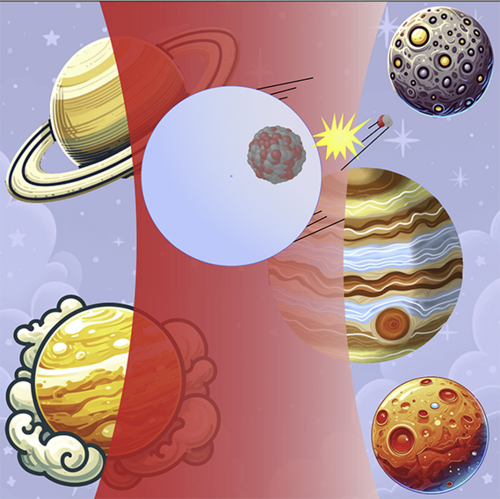
Yale Physics associate professor David Moore’s group has pioneered a technique that opens up possibilities for detecting dark matter, neutrinos, and other mysteries of the Universe using a small, table-top experiment located at Yale’s Wright Lab called Search for new Interactions in a Microsphere Precision Levitation Experiment (SIMPLE).
A new publication led by Yale Applied Physics graduate student Jiaxiang Wang in “Physical Review Letters” called “Mechanical Detection of Nuclear Decays” explains the result. Other members of the group who contributed to the publication are Moore; physics postdoctoral associate Tom Penny; physics graduate students Benjamin Siegel and Yu-Han Tseng; and physics undergraduate student Juan Recoaro. All Moore group members are also members of Wright Lab.
According to Wang, the purpose of this experiment was to see if it is possible to detect a naturally occurring nuclear decay of elements embedded in a particle just by its mechanical response, and the results showed that this was, in fact, possible.
Mechanical detection of nuclear decays
The SIMPLE experiment in general is set up to use lasers to levitate a tiny micron-sized particle (a glass sphere) within a vacuum. A variety of particles that have no electric charge—such as neutrinos and candidates for dark matter—can be emitted in nuclear decays but are difficult to detect and measure with traditional experiments because they do usually not interact within a detector. For example, Moore explained, a neutrino from a nuclear decay could travel through about a light year of lead before interacting.
To provide a solution to the above issue, the Moore group aims to detect the tiny force imparted by the decay on the object where the decay occurred, rather than the escaping decay products themselves. To accomplish this, the group doped the particle with a radioactive lead isotope that can eventually decay to other unstable isotopes emitting alpha particles (which are relatively easy to detect mechanically), so that when the isotope naturally experiences decay, the energy transfer from the decay will “kick” the sphere and cause it to recoil. The momentum of this tiny, reactionary movement of the sphere can be measured to better understand the nature of the particle being studied and the products of its decays.
Wang said, “Detecting a mechanical recoil of a sphere larger than the particle of interest has many applications in nuclear and neutrino physics and was never considered before.
Moore said, in an interview with “Chemistry World,” “This technique, of seeing something recoil, is very general, it’s just Newton’s law. That can allow us to learn about particles we could otherwise not detect.”
Wang added, “This is a novel technique that can be used on a small scale and mitigates the problem of needing large detectors for questions in nuclear science.”
Challenges of the experiment
Wang explained that the biggest challenge for the experiment was figuring out how to dope the sphere, which took the group some time to figure out.
For future experiments that may require additional sensitivity, it will also be necessary to make sure that the force of the lasers acting on the particle is not included in the measurements of the momentum kick.
Wang said, “When a particle exists on the planet, it always experiences gravity. If one wants to levitate a particle in a vacuum, we always have to exert a force—this can be optical, magnetic, or electric—but always a force that brings noise that needs to be characterized. SIMPLE uses lasers, which can cause noise by itself. This is an observable effect at low pressure. This effect did not affect the experiment described in the paper at all, but we plan to utilize a lot of careful design considerations for future experiments to be able to minimize these sources of noise in our data in the future.”
Results in the media
Wang’s paper has sparked a lot of interest in the scientific community and has led to articles in “Physics Today,” “Chemistry World,” and “Physics Magazine”. Additionally, “Physics Magazine” turned the paper into a comic.
Wang said, “I was pleasantly surprised at how accurate the comic really was. For instance, the content they used on the blackboard were not just random formulas, but actual graphs from the paper; as well as the image they used to explain the momentum.”
Future possibilities
Wang explained that the experiment described in the paper is a proof of principle that it is possible to study fundamental particles mechanically to directly measure the momentum. By using even smaller nanospheres, the team can use this technique to search for sterile neutrinos. If the sensitivity could someday be improved well beyond the “standard quantum limit,” it might allow even more ambitious research, such as detecting and measuring the mass of the Standard Model neutrino.
This article is taken from the Wright Lab news article of August 2, 2024, by Victoria Misenti.